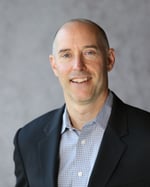We asked our 2023 featured industry leaders: Where is the DSO industry now? What will be different and where do you predict the industry is headed in 2024? Any company news? Any thoughts on emerging technologies in 2024?
Hot topics in all DSOPro categories in 2023 were emerging technologies, AI, machine learning, automation, cyber security and attacks, medical-dental collaboration, and new apps and softwares. Technology topics covered also included new ways to analyze technology investment opportunities and promote the growth of technology innovators, new analytic tools for making data-based decisions, an app for DSOs hiring temps or staff, and dental membership plans.

Paul Blocchi
Founder, RushTree Business Optimization
 In 2024, healthcare organizations are positioned to transform business operations and stakeholder relationships through emerging technologies like artificial intelligence, machine learning, and automation.
In 2024, healthcare organizations are positioned to transform business operations and stakeholder relationships through emerging technologies like artificial intelligence, machine learning, and automation.
RushTree.com is spearheading the shift to optimize data with AI to provide highly customized engagement across patients, providers, partners—and employees who power it all.
Our THRIVE, MAX, and PULSE solutions allow healthcare organizations, especially dental manufacturers, and distributors, to optimize everything from customer/patient support to operations, production planning, and inventory management. By processing signals from across supply chains and departments, our AI models optimize workflows, forecast demand, mitigate risks, and direct intelligent automation of key processes and administrative tasks. Team productivity and morale rises as tedious work declines.
We also enable personalized healthcare experiences by understanding, simplifying, and automating key data and processes to uncover patient and provider insights. As a result, the patient and partner experience become coordinated, holistic, and tailored to specific needs—strengthening satisfaction.
By infusing critical operations and touchpoints with artificial and human intelligence throughout healthcare ecosystems, RushTree.com paves the way for systems to learn, reason, and guide decisions autonomously. This represents the next generation in not just elevating outcomes—but forging trusted relationships between organizations and communities.
We help healthcare leaders and teams enhance precision, efficiency, and care while allowing people to focus on higher-level objectives. In partnership, humans and technology can reimagine sustainable value creation through infused AI.
SPONSORED

|
Smooth Scanning with Expert Glidewell Support
The fastscan.io™ Scanning Solution combines Medit® i700® technology with the digital workflow of glidewell.io™, plus personalized ongoing support from a Glidewell technician. Includes a portable cart, laptop, monitor, and no monthly or subscription fees.

|
Doug Brown, Thomas Sharpe
Co-Founders, Dental Innovation Alliance (DIA)

 The DSO industry has been pinched lately by the macro environment including higher interest rates, inflation, and labor scarcity. Good people are harder than ever to attract and retain. And new patients are more scarce, as are suitable third-party financing options, it seems.
The DSO industry has been pinched lately by the macro environment including higher interest rates, inflation, and labor scarcity. Good people are harder than ever to attract and retain. And new patients are more scarce, as are suitable third-party financing options, it seems.
Macro conditions will likely continue to ameliorate. However, people (teammates and new patients) will remain more elusive as consolidation and competition continues to ramp in the DSO space. The ongoing revelation and promotion of the connection of oral health and systemic health will progress. Innovative technology stands ready to help on many of these topics.
Dental Innovation Alliance (DIA) is rapidly growing with new DSOs and other industry participants joining. We are building our Alliance concept to generate more information for end users of innovation and more opportunities for DIA-supported innovators to connect with those end users. 2024 will entail many exciting DIA launches as we continue to grow and deploy more capital. Additionally, we are planning a podcast launch to further enhance the foregoing efforts.
We track over 40 unique vectors of dental innovation. We are interested in several vectors in the near term. AI is a prolific area of interest and activity. We look for more AI involvement in dental innovation beyond pathology detection from diagnostic image review. RCM is an area that we are largely pursuing as well. We are seeking solutions that integrate with most or all practice management software platforms and that have insurance verification capability as well.
At DIA, we want to find solutions to attract and retain more of the elusive talent to dental offices and then provide the tools such that the more limited number of teammates in those offices have the best possible resources with which to delight patients. From better support of the front desk and management team to earlier detection of patient conditions to better treatment modalities…these are force multipliers, these enhance patient delight, and these help investors see maximum value. In its role of dental innovation investment and promotion, DIA seeks to be the rising tide raising all stakeholder boats – supported innovators, investors, health professionals, patients, and the industry at large.
SPONSORED

|
Save Time on Hygiene Appointments
Easily slide this onto the saliva ejector to provide continuous, comfortable, hands-free suction with no additional attachments required.

|
Gary Salman
CEO, co-founder, Black Talon Security
 With the economic conditions forecasted for 2024, many DSOs may need to focus on same-store growth as borrowing costs continue to inhibit acquisition models. This makes it even more critical to ensure the security of the operations within locations currently in the group.
With the economic conditions forecasted for 2024, many DSOs may need to focus on same-store growth as borrowing costs continue to inhibit acquisition models. This makes it even more critical to ensure the security of the operations within locations currently in the group.
Cybersecurity experts predict that the number of cyberattacks targeting healthcare organizations will continue to increase at an accelerated rate in 2024. DSOs/DMOs have become a favorite target for international hacking organizations due to the data that they store and the size of their patient databases. We have witnessed more sophisticated attacks, often aided by AI technology, to infiltrate networks and trick staff into releasing their credentials.
Cybercriminals are also heavily targeting network vulnerabilities that exist in every office to exploit any weak link that can give them access to valuable patient data. Data theft is often the goal as these threat actors know once they obtain patient records you will be forced to pay the ransom demand, or likely face higher government penalties if they begin to leak the records.
While every organization should have a cyber insurance policy in place, insurance alone shouldn’t be relied upon to replace proper cybersecurity measures for the business. Many group practices who thought that they had adequate coverage found out too late that they were woefully under-insured as the mounting costs stacked up. All DSOs should factor in a 10- to 14-day complete loss of business income, a ransom payment that is likely to exceed $1 million, and the cost of recovery, patient notification, and legal fees.
A DSO's attack surface quickly grows when adding new locations, new staff, and when integrating new equipment and software applications—and it is critical to have a cyber strategy in place that protects business continuity. Black Talon continues to invest heavily in our EAGLEi® security platform, which makes it simple for DSO leaders and their IT teams to monitor business risk level, track compliance, and significantly reduce the chance of a cyberattack affecting their organization.
SPONSORED

|
What’s at stake should your DSO experience a data breach?
Reducing cyber risk has become paramount for every DSO. Entrusted with vast amounts of sensitive patient data, DSOs are particularly vulnerable to cyberthreats due to this sheer number of records. Black Talon’s latest guide for DSO leaders provides insights into the cyberthreat landscape and what is at stake for your organization should you experience an attack.

|
Darius Somekhian
Head of Partnerships, Cloud Dentistry
 The adage of dentists operating on a “lonely island” has been confirmed, and that’s why the DSO partnership route is attractive. Once partnered, the owner can focus on patients and less on the many variables a dentist practice owner faces when operating as a solo practitioner. Dentistry is a unique industry; I have yet to see another industry that requires a business owner, aka private practice owner, to become sequestered in managing so many variables, from the 1,001 widgets a dentist needs to buy to operate the office to unlocking the “insurance game.” Let’s face it: a private practice owner who wants to sell to a DSO is looking for the promise of a bigger piece of a smaller slice while eliminating all their management headaches, which frankly, they were never taught in school, but that’s a different story. Between the two, eliminating management headaches is more appetizing than the promise of financial gain to the burned-out dentist. Yet, unfortunately, most private practitioners under the age of 45 are burned out and are losing hopes of financial success due to the lack of traction they face.
The adage of dentists operating on a “lonely island” has been confirmed, and that’s why the DSO partnership route is attractive. Once partnered, the owner can focus on patients and less on the many variables a dentist practice owner faces when operating as a solo practitioner. Dentistry is a unique industry; I have yet to see another industry that requires a business owner, aka private practice owner, to become sequestered in managing so many variables, from the 1,001 widgets a dentist needs to buy to operate the office to unlocking the “insurance game.” Let’s face it: a private practice owner who wants to sell to a DSO is looking for the promise of a bigger piece of a smaller slice while eliminating all their management headaches, which frankly, they were never taught in school, but that’s a different story. Between the two, eliminating management headaches is more appetizing than the promise of financial gain to the burned-out dentist. Yet, unfortunately, most private practitioners under the age of 45 are burned out and are losing hopes of financial success due to the lack of traction they face.
Only a little has changed recently going into 2024. The DSO growth pace has slowed. Could this be because the pace at which dentistry is being injected with technology is helping solo practitioners alleviate headaches and streamline their businesses, all at the cost of a few hundred SaaS models? There are tools accessible to solo practices that can replace a decent chunk of the “DSO reliance.” A new tech platform is released almost weekly now, and many of them are solving actual pain points backed by millions of dollars, ready to be first to market.
It’s time for DSOs to reinvent and add more value other than money and support with the day-to-day back-end processes. It’s becoming “dentists on a lonely island surrounded by robots,” if you can imagine. DSOs should adopt and embrace software solutions, starting with platforms that solve dentistry’s biggest pain points, like staffing.
More from the Newsletter
